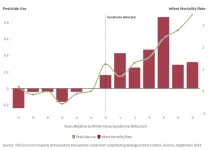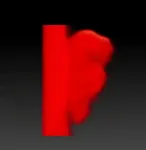(Press-News.org) Bats are considered a natural pesticide, widely relied on by farmers as an alternative to chemical pesticides to protect their crops from insects. But since 2006, many bat populations have collapsed in counties in North America due to an invasive fungus found in the caves bats use during the day and throughout winter that causes what is known as White-Nose Syndrome. A new study in Science uses their sudden collapse to explore whether farmers turned to chemical pesticides, and whether doing so impacts human health. It finds that farmers did increase their pesticide use, leading to more than 1,000 infant deaths.
“Bats have gained a bad reputation as being something to fear, especially after reports of a possible linkage with the origins Covid-19,” says study author Eyal Frank, an assistant professor at the Harris School of Public Policy. “But bats do add value to society in their role as natural pesticides, and this study shows that their decline can be harmful to humans.”
Frank compared the effect of bat die-offs on pesticide use in counties that experienced those bat population declines to counties that were likely unaffected by the wildlife disease. He found that when the bat populations declined, farmers increased their use of pesticides by about 31 percent. Because pesticides have been linked to negative health impacts, Frank next tested to see if the increased use of pesticides corresponded with an increase in infant mortality—a common marker to study the health impacts of environmental pollution. Indeed, when farmers increased their use of pesticides, the infant mortality rate rose by almost 8 percent. This corresponds to an additional 1,334 infant deaths. Or, for every 1 percent increase in pesticides, there was a 0.25 percent increase in the infant mortality rate.
The study also found that pesticides aren’t as good at preventing pests as bats. The quality of the crops likely declined, as farmers’ revenue from crop sales decreased by nearly 29 percent. Combining this revenue loss with the expense of the pesticides, farmers in communities that experienced the bat die-offs lost $26.9 billion dollars between 2006 and 2017. Adding onto those losses the $12.4 billion in damages from infant mortality, the total societal cost from the bat die-offs in these communities amounted to $39.6 billion.
“When bats are no longer there to do their job in controlling insects, the costs to society are very large—but the cost of conserving bat populations is likely smaller,” says Frank. “More broadly, this study shows that wildlife adds value to society, and we need to better understand that value in order to inform policies to protect them.”
END
The collapse of bat populations led to more than a thousand infant deaths
A new Science study shows that when communities experienced the near death of entire insect-eating bat populations, farmers increased their use of pesticides. This in turn increased the infant mortality rate
2024-09-05
ELSE PRESS RELEASES FROM THIS DATE:
Emotional contagion promotes resilience via serotonin release in mice
2024-09-05
“Bystander” mice that briefly watched other mice be harmed show fewer signs of behavioral despair when faced with their own harmful event, compared to mice who do not observe their fellow mice being harmed. The negative emotional contagion experienced by the bystander mice appears to build resilience against a depressive-like state, according to new research by Sarah Mondoloni and colleagues. Mondoloni et al. demonstrate that resilience in these mice requires an increase in serotonin release in a part of the brain called the lateral habenula. “These findings support the notion that, as is the case in humans, graded trauma can be resilience-promoting, enabling ...
Tiny glass beads indicate volcanism on the Moon 120 million years ago
2024-09-05
There were volcanic eruptions on the Moon as recently as 120 million years ago, according to a new analysis of a lunar sample collected by the Chang’e‑5 mission. Samples collected by the Apollo, Luna and Chang’e‑5 missions have previously shown there was widespread basaltic volcanism on the Moon extending from about 4.4 to 2.0 billion years ago. The new findings demonstrate that volcanism persisted much longer than was previously suspected, at least on smaller, more localized scale. Bi-Wen Wang, Qian W.L. Zhang and colleagues sorted through more than 3000 tiny glass beads they recovered from a lunar sample collected by Chang’e‑5, examining the bead’s ...
Injected fibroblasts transform to give thin skin a tough new identity
2024-09-05
The thick and tough skin on our palms and soles, called volar skin, stands up well under high-pressure conditions. This type of skin would be welcome on the limb stumps of amputees, since these points of contact with prostheses are covered in thin, non-volar skin that can be damaged over time. Now, Sam Lee and colleagues demonstrate that an injection of volar fibroblasts into non-volar skin in a group of human volunteers can promote volar features in the thin skin that last up to five months. Based on their analysis, Lee et al. are now enrolling amputees in a phase 2 clinical trial to further explore volar fibroblasts as a future ...
Novel study reveals how aging immune system fuels cancer growth, potentially opening new avenues for prevention
2024-09-05
New York, NY [September 5, 2024]—A novel study by researchers at the Icahn School of Medicine at Mount Sinai addresses a critical yet under-explored question in cancer research: Why is aging the biggest risk factor for cancer? The study reveals how an aging immune system spurs tumor growth, offering new insights into cancer prevention and treatment, especially for older adults.
Details on the findings were reported in the September 5 Online First Release of Science [DOI:10.1126/science.adn0327]. In preclinical models, the research team found that anakinra, a drug typically used for inflammatory conditions such as rheumatoid arthritis, can be repurposed to block harmful signals between ...
Researchers prove 120-million-year-old volcanism on moon
2024-09-05
Extensive geologic evidence of ancient volcanic activity can be found on the Moon, but how long this volcanism persisted has been unclear. However, Prof. LI Qiuli’s Lab at the Institute of Geology and Geophysics of the Chinese Academy of Sciences (IGGCAS) has recently identified three volcanic glass beads from lunar soil samples collected by the Chang’e-5 mission. Their research shows that the beads were formed 123±15 million years ago (Ma), thus representing the youngest lunar ...
State-by-state data boosts bird conservation planning
2024-09-05
ITHACA, N.Y. – New data summaries from the Cornell Lab of Ornithology’s eBird platform will help state wildlife planners assess the status of bird populations that live in or pass through their state – a crucial tool in protecting species.
A team of data scientists at eBird, the participatory science platform, has packaged summaries covering every bird species, in every state, and made them available online for free. These data summaries will help states prepare their federally required ...
Study on E. coli outbreak in the UK demonstrates increasing impact of climate change on public health and food security
2024-09-05
A study published in Eurosurveillance to investigate an outbreak of Shiga toxin-producing Escherichia coli (STEC) O157:H7 in the UK identified contaminated lettuce as the most likely source of the infection, and determined that heavy rainfall and flooding may have carried STEC from animal faeces to the lettuce crops. More heavy rainfall events are expected due to climate change in the future, leading to increased impacts on health and food security.
Ahead of Field Epidemiology Day 2024, this study demonstrates the value of field investigations in quickly responding to outbreaks, improving preparedness, and protecting public health, and possible ...
Using 3D imaging to transform plastic waste recycling
2024-09-05
In a global first, University of Waterloo researchers have used 3D imaging technology to understand the fine details of microplastics, paving the way for more effective methods of plastic waste recycling.
Micro and nanoplastics, tiny particles of plastic that come from the breakdown of larger plastic items, have become an exponentially worsening environmental crisis. Due to their difficulties in safely decomposing, plastic pollution poses significant threats to ecosystems, wildlife and human health.
Scientists have struggled to understand the exact process of ...
Case for inflammatory memory for hematopoietic stem and progenitor cells in AML niche
2024-09-05
“In this research perspective, we discuss recent work from our lab describing an active role of HSPCs in AML and the potential implications.”
BUFFALO, NY- September 5, 2024 – A new research perspective was published in Oncotarget's Volume 15 on September 4, 2024, entitled, “Trained and ready - the case for an inflammatory memory for hematopoietic stem and progenitor cells in the AML niche.”
As noted in the abstract of this paper, lifelong hematopoiesis is sustained by the crosstalk between hematopoietic stem and progenitor cells (HSPCs) and specialized bone marrow ...
For many animals sleep is a social activity, but it’s usually studied as an individual process
2024-09-05
Group sleeping can impact when animals sleep, how long they sleep for, and how deeply they sleep. For example, groups of meerkats time their sleep according to “sleep traditions”; olive baboons sleep less when their group size increases; bumblebees suppress sleep in the presence of offspring; and co-sleeping mice can experience synchronized REM sleep. To fully understand both sleep and animal social structures, we need to pay more attention to the “social side” of sleep, animal behaviorists argue in an opinion paper publishing September 5 in the Cell Press journal ...
LAST 30 PRESS RELEASES:
SEOULTECH researchers reveal strong public support for hydrogen fuel cell trucks
Dongguk University develops a new way to produce cheaper, more efficient green hydrogen
Scientists discover a hidden RNA “aging clock” in human sperm
New quantum boundary discovered: Spin size determines how the Kondo effect behaves
Ancient ‘spaghetti’ in dogs’ hearts reveals surprising origins of heartworm
Full value added tax on meat: a first step towards pricing the environmental damages caused by diets
Hidden mpox exposure detected in healthy Nigerian adults, revealing under-recognized transmission
Shingles vaccine linked to slower biological aging in older adults
A self-assembling shortcut to better organic solar cells
A two-week leap in breeding: Antarctic penguins’ striking climate adaptation
Climate risks to insurance and reinsurance of global supply chains
58% of patients affected by 2022 mpox outbreak report lasting physical symptoms
Golden Gate method enables rapid, fully-synthetic engineering of therapeutically relevant bacteriophages
Polar weather on Jupiter and Saturn hints at the planets’ interior details
Socio-environmental movements: key global guardians of biodiversity amid rising violence
Global warming and CO2 emissions 56 million years ago resulted in massive forest fires and soil erosion
Hidden order in quantum chaos: the pseudogap
Exploring why adapting to the environment is more difficult as people age
Society for Laboratory Automation and Screening welcomes new scientific director: Madeline M. Farley, Ph.D.
Austrian cow shows first case of flexible, multi-purpose tool use in cattle
Human nasal passages defend against the common cold and help determine how sick we get
Research alert: Spreading drug costs over the year may ease financial burden for Medicare cancer patients
Hospital partnership improves follow up scans, decreases long term risk after aortic repair
Layered hydrogen silicane for safe, lightweight, and energy-efficient hydrogen carrier
Observing positronium beam as a quantum matter wave for the first time
IEEE study investigates the effects of pointing error on quantum key distribution systems
Analyzing submerged fault structures to predict future earthquakes in Türkiye
Quantum ‘alchemy’ made feasible with excitons
‘Revoice’ device gives stroke patients their voice back
USF-led study: AI helps reveal global surge in floating algae
[Press-News.org] The collapse of bat populations led to more than a thousand infant deathsA new Science study shows that when communities experienced the near death of entire insect-eating bat populations, farmers increased their use of pesticides. This in turn increased the infant mortality rate





